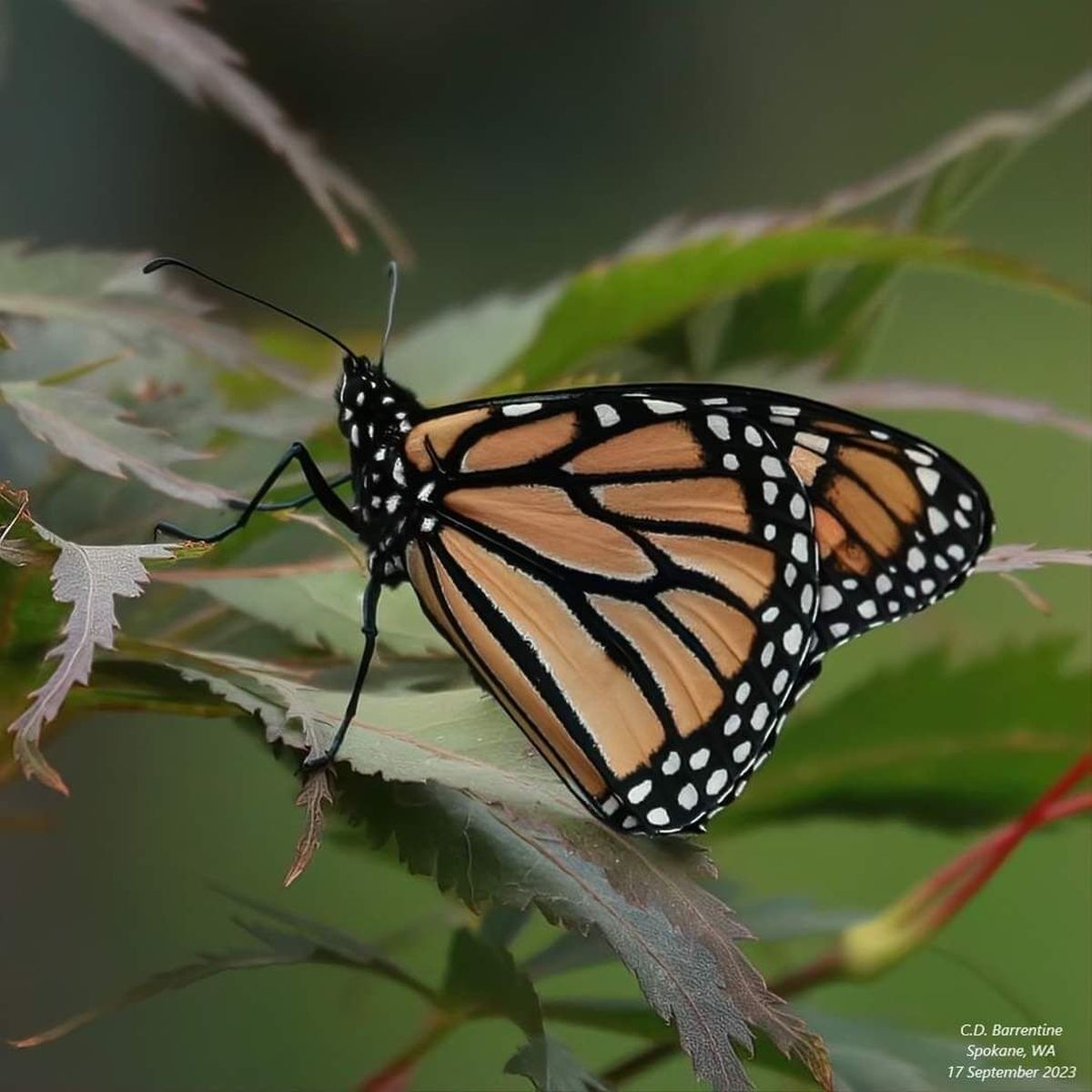A wild surprise: Spokane a ‘hot spot’ for monarch butterflies this summer

The monarch migration took a mysterious turn this summer when large numbers of the iconic butterfly veered off course and ended up in the Spokane area, instilling wonderment in the humans who observed them.
“People who contacted me were surprised to see them show up in locations where they are rarely seen,” said entomologist David James, a monarch researcher with Washington State University. “Spokane, in particular, was a hot spot this year.”
Naturalist Carl Barrentine is a retired biology professor who moved to Spokane from North Dakota more than six years ago. Each year, he figured he’d witness migrating monarchs just as he had while living in the Midwest.
“But I never observed a single one,” he said.
Until recently.
With sunlight illuminating their bright orange and black wings like stained glass, Barrentine documented three adult monarchs in the region within three weeks.
He spotted the first monarch on Aug. 26 “roller-coastering south with determined effort” above a street in South Spokane, he explained. The second fluttered across the road leading to the Mica Peak trailhead on Sept. 3. Both times, Barrentine was driving and wasn’t able to snap their photographs. Even so, he alerted James, who’s been tracking the western monarch’s migratory patterns for two decades.
Then on Sept. 17, Barrentine’s luck changed. Perched on a branch of an ornamental Japanese maple tree in his yard was a monarch butterfly.
An outdoor photographer, he raised the camera and captured the remarkable image.
It would be one of many Spokane-area monarch sightings reported to James this summer.
“We typically see only one or two vagrants each summer,” he said. But “for some reason, their main route of migration went through Spokane this year. They veered east. It’s very unusual.”
Of 88 confirmed monarch reports in Washington state, 41% were from the Spokane area, the highest concentration statewide, he explained.
Each spring, thousands of Western monarchs leave their overwinter roosting sites along the California coast, produce a spring generation in California, then head north to breed and lay eggs on milkweed in the Pacific Northwest, the only host plant for the species. Using an intricate internal compass, those that fly to Washington state typically follow migratory corridors along the Snake, Yakima and Columbia Rivers, James explained. Normally, they land in the south-central part of the state, including the Tri-Cities and Yakima areas.
But summer 2023 was not normal.
On June 15, James received the first confirmed report of a monarch sighting in the Spokane area. On June 22, he received another report. And then another. The numbers kept going up, mostly in Spokane but also in nearby Cheney, Mead and Medical Lake. Sightings were even reported on the Palouse.
When Kate Jaeckel spotted a monarch sipping nectar from a zinnia in her half-acre garden in Moscow on Aug. 13, she did a double-take. After 21 years of living on the Palouse, it was the first one she’d ever seen. Her sighting that day became one of seven reported in the Palouse region.
“It was so special,” said Jaeckel, who grows cut flowers as part of her business Orchard Farm Soap, attracting a variety of butterflies, moths and bees.
Growing up, she was accustomed to seeing monarchs each year in northern Wisconsin where she and her family spent summers.
“There were monarchs everywhere, so naturally, it was a welcome surprise to see one here,” she said.
The monarchs’ unexpected appearance to the area is especially surprising because their populations have plummeted since the early 1980s. It’s believed their drop in numbers is tied to habitat loss, changing weather patterns and the destruction of milkweed from herbicides, according to the Xerces Society for Invertebrate Conservation.
The species is mostly divided into two groups separated by the Rocky Mountains, the Western and Eastern monarchs, although there is some intermixing. After years of decline, there’s been a documented uptick in Western monarch numbers since 2021, rekindling hope among scientists and butterfly admirers alike. But the population increase alone doesn’t explain what lured the insect off its migratory path this year, James said.
“Fewer monarchs showed up in the areas they normally do in Washington,” James said, including Yakima, where he lives. “They appear to have gone to other locations instead.”
What brought these winged visitors to new locations – especially the Spokane area, where their concentration was highest?
“We don’t know why. It’s a mystery, like the monarch itself,” James said, referring to the grand riddle of how insects the weight of a paper clip are capable of traveling vast distances in a journey fraught with hungry birds, dwindling food sources, wind storms and semitrucks.
It’s possible we’ll never know why their finely calibrated navigation system guided them off course, he said – whether the diversion was weather or food-related, or they simply followed a primal instinct to survive after decades of loss.
“Variability is part of survival,” James said.
The monarch that Barrentine photographed in Spokane Sept. 17 was probably the second offspring of a relative that flew north from California in the spring. By now, it’s probably en route to its ancestor’s coastal overwintering grounds in California, James said, adding that there’s no way to know whether its descendants will return to Spokane next year.
But one thing we do know: The great monarch migration mystery just got more mysterious.